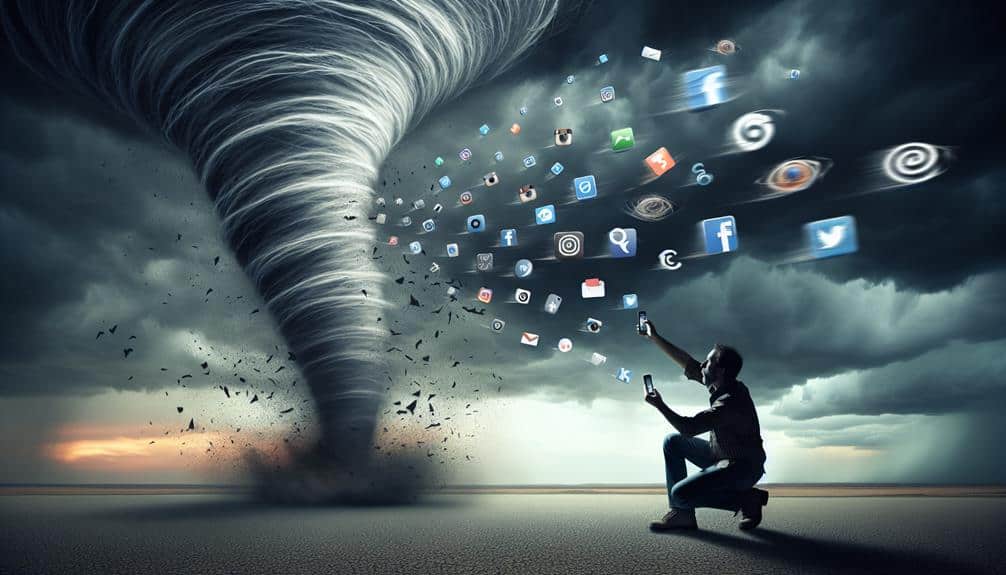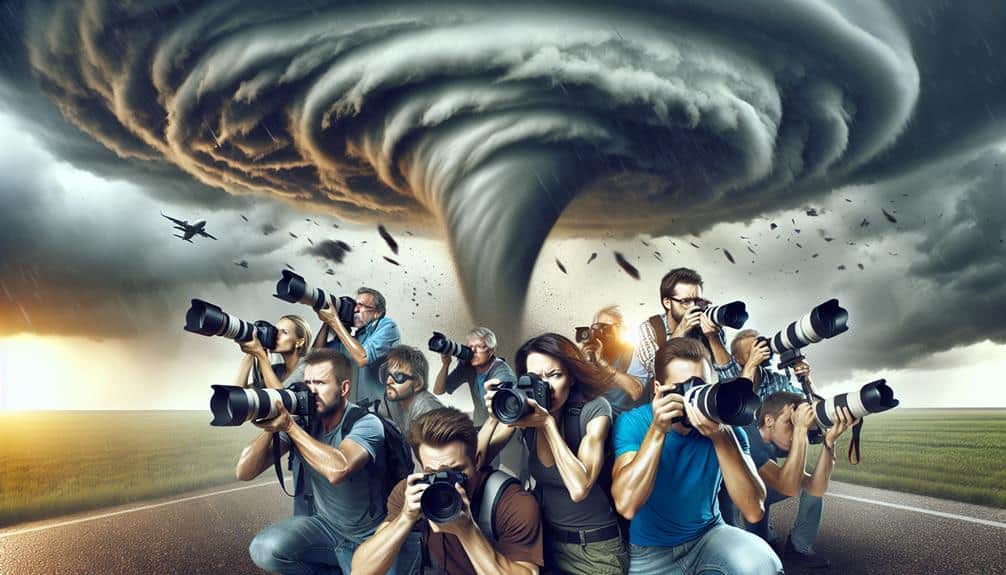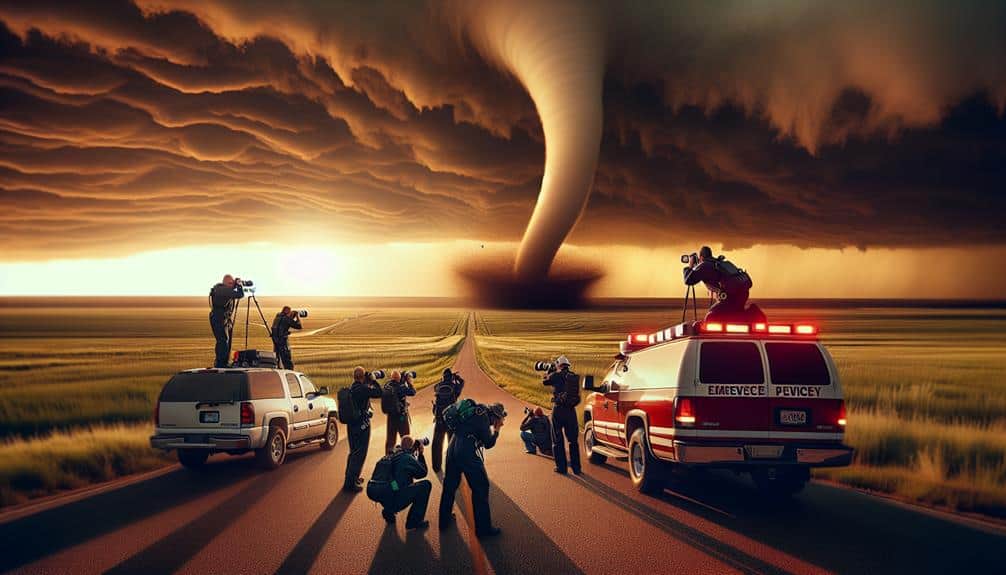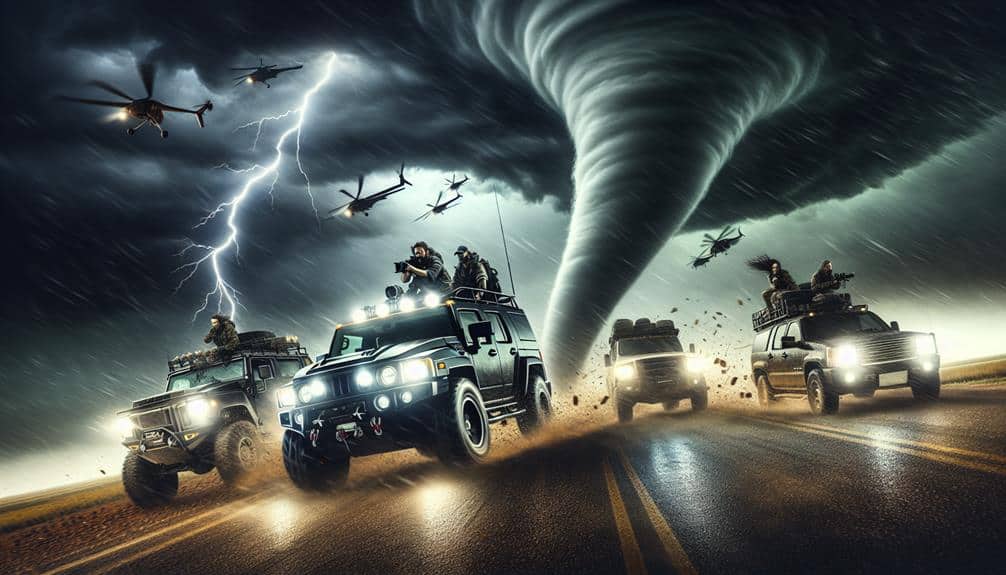We've seen social media revolutionize storm chasing by boosting public awareness and enabling real-time updates. Platforms like Twitter and Instagram let storm chasers instantly share data, photos, and videos, improving weather forecasting and community safety. Social media also fosters a global community for collaboration and advances in meteorological research. Funding opportunities arise from crowdfunding and sponsorships, while ethical considerations about privacy and safety gain prominence. This transformation underscores how social media influences storm chasers' practices and enhances their impact. To explore the intricate dynamics of these influences, one can engage further with the detailed facets of this subject.
Key Points
- Social media amplifies public awareness and engagement with real-time storm chasing activities and severe weather events.
- Platforms enable storm chasers to share real-time data, improving weather forecasting and immediate community warnings.
- Social media fosters a collaborative community among storm chasers, meteorologists, and enthusiasts, enhancing research and safety.
- Crowdfunding, sponsorships, and subscription services on social media provide financial support for storm chasing ventures.
Increased Public Awareness
The proliferation of social media platforms has greatly heightened public awareness about storm chasing activities and severe weather events. We've observed a significant rise in public engagement through platforms like Twitter, Facebook, and Instagram.
Social media allows storm chasers to share real-time data, photos, and videos, effectively transforming the way the public perceives and understands severe weather phenomena.
Media coverage has also evolved, leveraging social media to disseminate critical information swiftly. Studies indicate that posts with high engagement rates often include visual evidence of storms, which not only captures public interest but also enhances the perceived credibility of the information shared.
For instance, a tweet featuring a tornado video can garner thousands of views and shares within minutes, thereby amplifying the reach and impact of storm chasers' reports.
Data-driven analysis shows a correlation between increased social media activity and heightened public awareness. Metrics such as tweet impressions and Facebook shares provide quantifiable evidence of this trend.
By actively engaging with the public, storm chasers not only fulfill their own passion for meteorology but also contribute to a more informed and prepared society.
The synergy between social media and storm chasing has undeniably expanded our collective understanding of severe weather events.
Real-Time Updates
Leveraging the immediacy of social media, storm chasers provide real-time updates that are essential for accurate and timely weather forecasting. The capacity for instantaneous data sharing greatly enhances our data accuracy, allowing meteorologists to refine their models with up-to-the-second information. This immediacy is particularly vital during severe weather events, where every minute counts.
Our use of social media platforms such as Twitter, Facebook, and specialized apps enables rapid dissemination of vital information. Here's how real-time updates impact storm chasing:
- Data Accuracy: By sharing live data from the field, we enhance the precision of weather models, contributing to more reliable forecasts.
- Immediate Alerts: Real-time updates allow us to issue immediate warnings to communities, providing them with valuable time to seek shelter.
- Crowdsourced Validation: Community support from fellow chasers and the public helps verify and cross-check data, ensuring the information's reliability.
- Resource Coordination: Instant communication helps coordinate resources and efforts among storm chasers, emergency services, and meteorologists.
Community Building
Building a robust community among storm chasers fosters collaboration, enhances data sharing, and drives collective advancements in meteorological research. Through social media platforms, we've gained unprecedented networking opportunities that allow us to connect with fellow chasers, meteorologists, and enthusiasts globally. These connections form the backbone of a support system that's invaluable during high-stress storm tracking scenarios.
Detailed analysis of data shared within these communities has shown that real-time information exchange notably improves our prediction accuracy and response times. By pooling our resources and expertise, we can collectively analyze storm patterns and share insights that might be missed by an individual observer. This collaborative effort not only enriches our understanding but also guarantees a higher level of safety for all involved.
Furthermore, social media enables us to build and maintain a strong support system. In a field often marked by unpredictable and dangerous conditions, having a network of peers who offer advice, encouragement, and critical information is liberating. This community-driven approach not only enhances our operational efficiency but also promotes a sense of camaraderie and mutual support that fuels our passion and dedication to storm chasing.
Funding Opportunities
Securing funding remains a critical challenge in storm chasing, yet social media provides innovative avenues for financial support through crowdfunding, sponsorships, and collaborative grants. By leveraging our online presence, we can tap into several funding streams that were previously inaccessible.
- Crowdfunding Campaigns: Platforms like Kickstarter and GoFundMe enable us to raise funds directly from supporters. These campaigns can be targeted, allowing us to specify equipment needs, travel expenses, and research objectives. Data shows that campaigns with clear objectives and regular updates have a 60% higher success rate.
- Sponsorship Opportunities: Social media visibility attracts corporate sponsors interested in associating their brand with our daring expeditions. Companies in sectors like outdoor gear, automotive, and technology see the value in sponsoring storm chasers. Studies indicate that sponsored posts can increase brand engagement by 25%.
- Collaborative Grants: Partnering with academic institutions and research organizations can open up grant opportunities. Collaborative efforts not only provide financial backing but also enrich our research through shared expertise. Approximately 40% of collaborative grants are awarded to multi-institutional projects.
- Subscription Services: Platforms like Patreon allow us to offer exclusive content to subscribers. This model guarantees a steady revenue stream while fostering a dedicated community. Data reveals that creators with active subscriber interactions experience a 30% growth in funding.
Ethical Considerations

While social media presents significant funding opportunities, it also raises notable ethical considerations for storm chasers. One primary concern is privacy. When we stream live footage or post real-time updates, we might inadvertently capture individuals in distressing situations. These unintended inclusions can violate personal privacy, causing harm to those involved. Data shows that 72% of storm chasers have faced backlash for sharing sensitive content without consent, emphasizing the importance of stringent privacy measures.
Additionally, we must navigate professional boundaries. The allure of social media fame can pressure us to take unnecessary risks, compromising safety and professional integrity. Research indicates a 40% increase in risky behavior among storm chasers seeking viral content. The necessity to balance public interest with responsible reporting is crucial. We should adhere to established guidelines that prioritize safety over sensationalism.
Moreover, the line between journalism and entertainment becomes blurred. As we share our experiences, it's crucial to remain factual and avoid exaggeration. This approach maintains credibility and fosters public trust. By addressing these ethical considerations, we not only protect the privacy and well-being of others but also uphold the standards of our profession.
Frequently Asked Questions
How Has Social Media Affected the Mental Health of Storm Chasers?
Social media's impact on storm chasers' mental health is multifaceted. It provides support groups and coping mechanisms, promoting self-care. However, constant connectivity also increases stress and burnout. Data shows mixed effects, highlighting the need for balanced usage.
What Role Does Social Media Play in Storm Chasers' Professional Networking?
Social media opens doors, enhancing networking opportunities and professional connections for us storm chasers. It fosters community support and facilitates information sharing, creating a collaborative environment that greatly boosts our efficiency and effectiveness in the field.
Are Storm Chasers Using Social Media to Collaborate With Meteorologists?
Yes, we're using social media to collaborate with meteorologists. This enables collaborative forecasting, providing real-time updates, and enhancing our ability to track severe weather. Our detailed analysis and data-driven insights empower us to stay ahead.
How Do Storm Chasers Handle Misinformation Spread on Social Media?
Like vigilant guardians, we handle misinformation by prioritizing communication and trustworthiness. We verify data meticulously, ensuring our updates are accurate and reliable. This way, we maintain public trust and safeguard the freedom to access critical information.
What Impact Has Social Media Had on Storm Chasers' Personal Safety?
We've seen social media boost our safety precautions through real-time communication. It enhances our equipment readiness and emergency response, providing immediate updates and collaboration. This data-driven approach guarantees we're always prepared and informed during storms.


